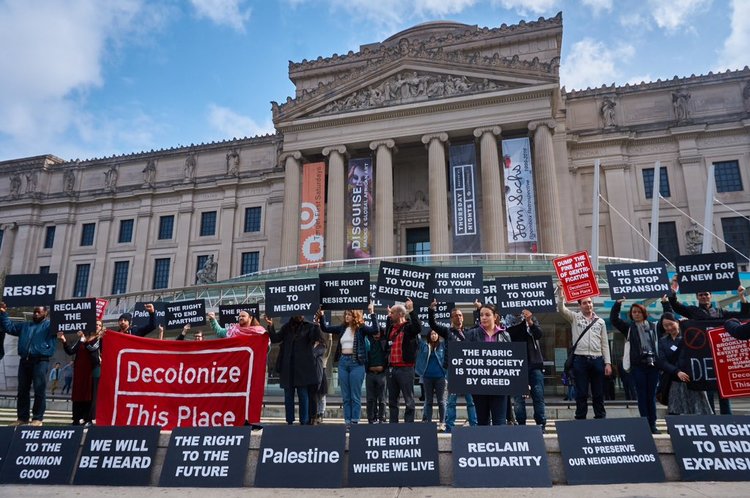Decolonize This Place
A Grassroots Movement in New York City
February 18, 2020
On January 31st, 2020 around 500 protestors gathered in Grand Central Terminal to protest recent increases in hiring for the MTA Police; an action which is part of a larger effort by the governor to crack down on fare evasion. The Grand Central Protest, called “J31” was organized by a coalition of anti-capitalist movements called the “MTL+” Collective. Its most recent actions concerning the MTA were made possible by Decolonize This Place, one such group in the collective. So who are Decolonize This Place, and what do they want? The Monitor reached out to DTP’s Instagram account and was redirected to their statements made to other press outlets, as well as their operations manual.
Their website calls DTP an “action-oriented movement and decolonial formation in New York City” made up of grassroots groups and art collectives. Most of DTP’s actions have focused on cultural spaces, such as museums–the group first gained prominence when they protested inside the Whitney museum, calling for the removal of Warren Kanders (whose company Safariland’s tear gas has been used against migrant families at the southern border, as well as against protestors in both Ferguson, MO, and the Standing Rock Indian Reservation). Kanders stepped down from his position at the Whitney in July of 2019.
However, the group has been active since 2016, primarily focusing their activism at museums. They first started out by organizing at the American Museum of Natural History, where they encouraged the renaming of Columbus Day to “Indigenous People’s Day”, as well as the removal of a statue of Teddy Roosevelt. Additionally, they attempted to highlight the ways that the museum allegedly depicted African and Native American art in a derogatory way.
This year, DTP is focusing on reacting to the MTA’s crackdown on fare evasion and the hiring of hundreds more police officers. They argue that the system of policing disproportionately targets racial minorities and the poor. Their operations manual contains a section about this very subject. Titled “Protect and Serve Who?”, it examines the history of policing in America and frames the history of New York’s police force as the history of a force made to “…control the immigrant working class and put down their wage rebellions”. Additionally, they argue that since the Cold War, America’s police forces have been conducting “domestic warfare against consent”, observing the increased militarization of local police forces. A popular tagline on communiqués distributed by DTP reads “We keep us safe because they won’t. They never have.”
So, why the subways? DTP’s Operations Manual argues that like the Transcontinental Railroad, “the builders of the city’s subway lines completed the work of settler expansion. They served capital by connecting to cheap labor pools; they delivered ‘virgin’ land to real estate developers, and over time, they brought gentrifiers to black and brown neighborhoods created by the white flight”. To DTP, the subways symbolize the mechanisms of oppression, and so their demands to make it free and accessible to all are an attempt at justice for the crimes of the past.
DTP’s methods are reminiscent of civic disobedience movements from throughout American history. A focus is made on disrupting the avenues of normalcy as a way of making their voices heard. This started with mass turnstile-hopping campaigns, and eventually morphed into demonstrations at one of America’s most iconic train stations: Grand Central Terminal. DTP also encourages people to create protest art and “swipe it forward”. Their operations manual also instructs demonstrators not to carry weapons.
Critics of DTP mostly criticize their methods. The New York Daily News’ editorial board argues that “trashing the subway is a crime, not political speech”, and by disrupting the subway system, they’re actually just making things harder for the people who need it to work. However, Amin Hussain, an organizer for DTP told the Gothamist that “this movement is about creating a space for people to resist in their own ways, and to create a pressure completely outside the power structure that forces that structure, if it wants to stay at the center of the conversation, to make concessions. But we’re not trying to cooperate with non-profit advocacy groups or liberal politicians. If the political system isn’t working, why would you appeal to continue to appeal to that structure?”
Decolonize This Place can be found at www.decolonizethisplace.org, where you can view the Operations Manual quoted by the Monitor in this article.

